大家都说反射耗性能,但是到底有多耗性能,哪些反射方法更耗性能;这些问题却没有统一的描述。
本文将用数据说明反射各个方法和替代方法的性能差异,并提供一些反射代码的编写建议。为了解决反射的性能问题,你可以遵循本文采用的各种方案。
反射各方法的性能数据
我使用 BenchmarkDotNet 基准性能测试来评估反射各个方法的性能。测试的程序基于 .NET Core 2.1 开发。
先直观地贴出我的运行结果:
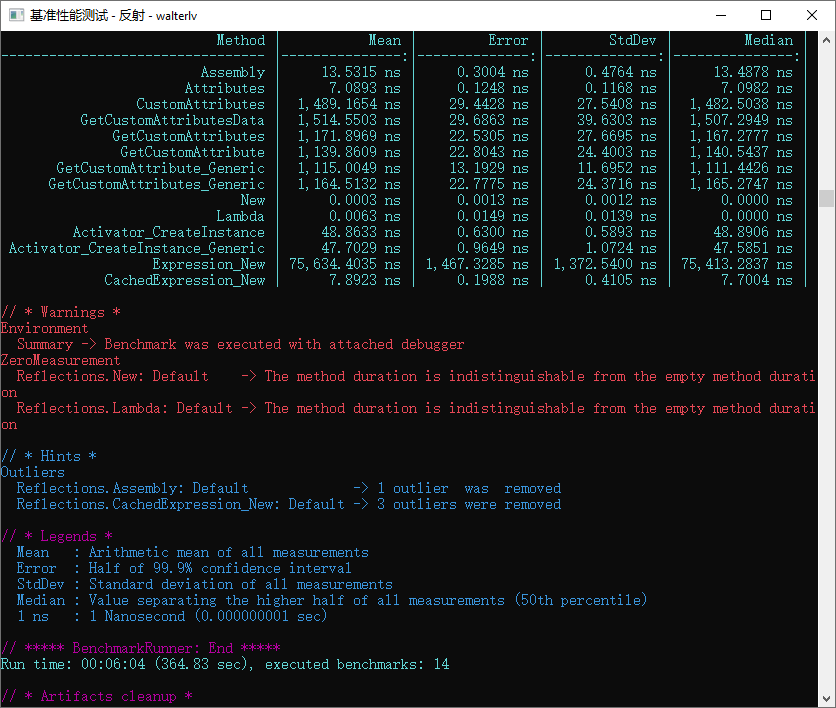
▲ 各反射不同方法的运行基准测试结果
我把上面的表格复制下来成为文字,这样你也可以拿走我的这部分数据:
| Method | Mean | Error | StdDev | Median |
|---|---|---|---|---|
| Assembly | 13.5315 ns | 0.3004 ns | 0.4764 ns | 13.4878 ns |
| Attributes | 7.0893 ns | 0.1248 ns | 0.1168 ns | 7.0982 ns |
| CustomAttributes | 1,489.1654 ns | 29.4428 ns | 27.5408 ns | 1,482.5038 ns |
| GetCustomAttributesData | 1,514.5503 ns | 29.6863 ns | 39.6303 ns | 1,507.2949 ns |
| GetCustomAttributes | 1,171.8969 ns | 22.5305 ns | 27.6695 ns | 1,167.2777 ns |
| GetCustomAttribute | 1,139.8609 ns | 22.8043 ns | 24.4003 ns | 1,140.5437 ns |
| GetCustomAttribute_Generic | 1,115.0049 ns | 13.1929 ns | 11.6952 ns | 1,111.4426 ns |
| GetCustomAttributes_Generic | 1,164.5132 ns | 22.7775 ns | 24.3716 ns | 1,165.2747 ns |
| New | 0.0003 ns | 0.0013 ns | 0.0012 ns | 0.0000 ns |
| Lambda | 0.0063 ns | 0.0149 ns | 0.0139 ns | 0.0000 ns |
| Activator_CreateInstance | 48.8633 ns | 0.6300 ns | 0.5893 ns | 48.8906 ns |
| Activator_CreateInstance_Generic | 47.7029 ns | 0.9649 ns | 1.0724 ns | 47.5851 ns |
| Expression_New | 75,634.4035 ns | 1,467.3285 ns | 1,372.5400 ns | 75,413.2837 ns |
| CachedExpression_New | 7.8923 ns | 0.1988 ns | 0.4105 ns | 7.7004 ns |
如果你希望了解以上每一项的意思,可以通过阅读本文文末的代码来了解其实现。基本上名称就代表着反射调用相同的方法。
你一定会说这张表不容易看出性能差距。那么我一定会放图:
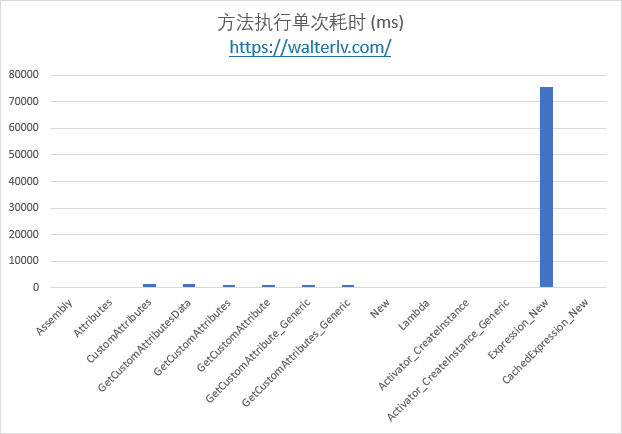
那个 Expression_New 在图中独树一帜,远远把其他方法甩在了后面。那是个什么方法?
那是在使用 Expression 表达式创建一个类型的新实例:
1
2
3
var @new = Expression.New(typeof(ReflectionTarget));
var lambda = Expression.Lambda<Func<ReflectionTarget>>(@new).Compile();
var instance = lambda.Invoke();
也就是说,如果你只是希望创建一个类型的新实例,就不要考虑使用 Expression.New 的方式了。除非此方法将执行非常多次,而你把那个 lambda 表达式缓存下来了。这对应着图表中的 CachedExpression_New。
其他的现在都看不出来性能差异,于是我们把耗时最长的 Expression_New 一项去掉:
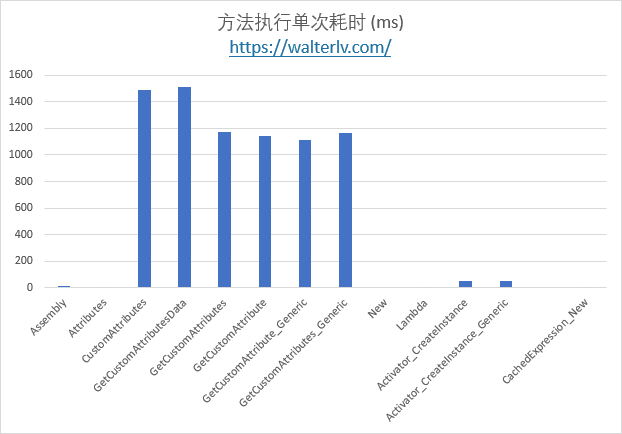
我们立刻可以从图中得到第二梯队的性能巨头 —— 就是 CustomAttributes 系列。我使用了多种不同的 CustomAttribute 获取方法,得到的结果差异不大,都“比较耗时”。不过在这些耗时的方法里面找到不那么耗时的,就是 Type 的扩展方法系列 GetCustomAttribute 了,比原生非扩展方法的性能稍好。
不过其他的性能差异又被淹没了。于是我们把 CustomAttributes 系列也删掉:
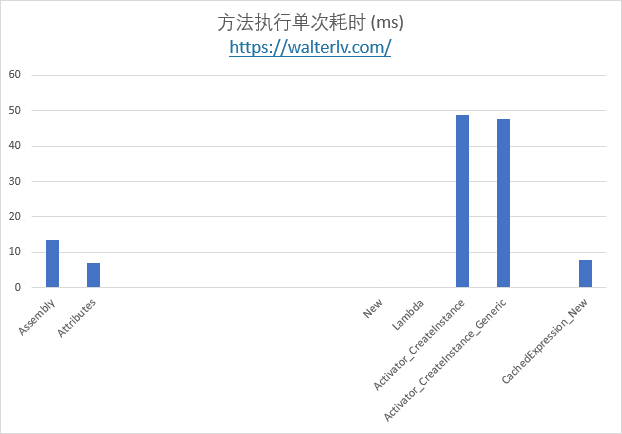
于是我们又得到了第三梯队的性能大头 —— Activator.CreateInstance 系列。而是否调用泛型方法的耗时差异不大。
然后,我们把 Activator.CreateInstance 也干掉,可以得到剩下其他的性能消耗。
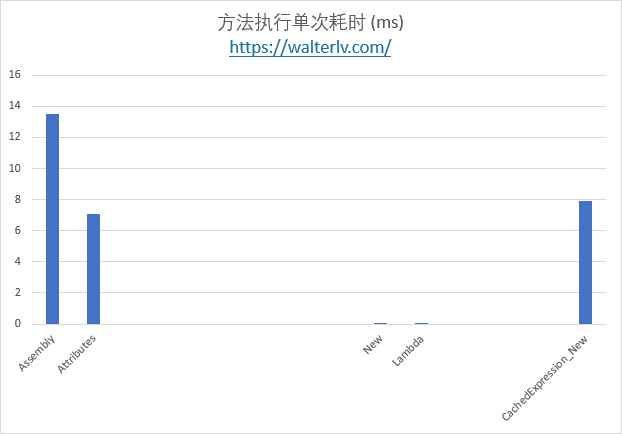
也就是说,只是获取 Type 中的一些属性,例如 Assembly 和 Attributes 也是比较“耗时”的;当然,这是纳秒级别,你可以将它忽略。
要不要试试把第四梯队的也干掉呢?于是你可以得到 new 和 Lambda 的差异:
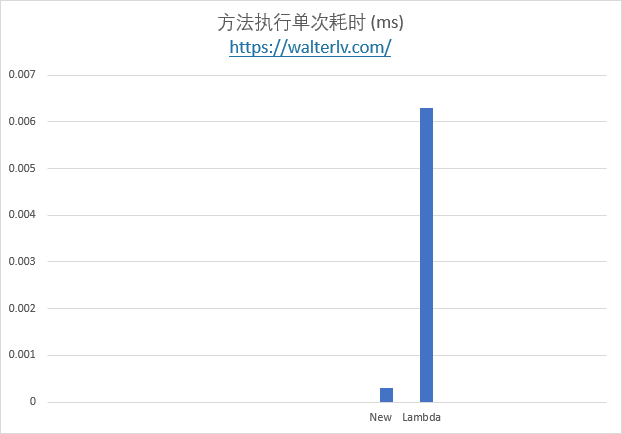
原本在上面所有图中看起来都没有时间的 new 和 Lambda 竟然差异如此巨大;不过,这都是千分之一纳秒级别了;如果你创建的类数量不是百万级别以上,你还真的可以忽略。
而 new 指的是 new Foo(),Lambda 指的是 var func = () => new Foo(); func();。
对于 GetCustomAttribute,还有另一个方法值得注意:IsDefined;可以用来判断是否定义了某个特定的 Attribute。
1
2
3
4
5
var isDefined = _targetType.IsDefined(typeof(ReflectionTargetAttribute), false);
if (isDefined)
{
var attribute = _targetType.GetCustomAttribute<ReflectionTargetAttribute>();
}
而这个方法与 GetCustomAttribute 的性能差距也有些大:
| Method | Mean | Error | StdDev | Ratio | RatioSD |
|---|---|---|---|---|---|
| IsDefined | 653.8 ns | 13.07 ns | 16.53 ns | 1.00 | 0.00 |
| GetCustomAttribute | 1,149.6 ns | 22.97 ns | 22.56 ns | 1.76 | 0.06 |
| GetGenericCustomAttribute | 1,216.5 ns | 24.15 ns | 54.51 ns | 1.81 | 0.07 |
咋看之下似乎与 GetCustomAttribute 方法重复,而且如果先判断再获取,可能总时间更长。不过这种方法就是适用于一次性对大量类型进行判断,如果只有少量类型定义了某种 Attribute,那么提前使用 IsDefined 判断可以获得总体更加的性能。
反射的高性能开发建议
创建类型的实例
如果你能访问到类型:
- 建议直接使用
new,性能最好。 - 如果不希望直接
new出来,可以考虑使用Func或者Lazy创建。这时会多消耗一些性能,不过基数小,增量不大。
如果你不能访问到类型:
- 如果只能从
Type创建,则使用Activator.CreateInstance系列。 - 如果你使用其他方式创建,请一定使用缓存。
除了使用 Expression 创建,你还可以使用 Emit 创建,不过这也要求能够访问到类型:
对于缓存,可以参考:
对于创建对象更多的性能数据,可以参考:
反射获取 Attribute
获取 Attribute 也是耗时的操作。
- 如果你只是获取极少数类型的
Attribute,建议直接调用GetCustomAttribute扩展方法。 - 如果你需要判断大量类型的
Attribute,建议先使用IsDefined判断是否存在,如果存在才使用GetCustomAttribute方法获取真实实例。
反射调用公共 / 私有方法
反射调用方法与构造方法几乎是一样的,不同之处就在于公共方法可以创建出委托缓存,而私有方法却不行。
有了委托缓存,你只有第一次才需要真的调用反射,后续可以使用缓存的委托或 Lambda 表达式;而私有方法是无法创建的,你每次都需要通过反射来调用相关方法。
关于私有方法的反射:
关于缓存:
使用预编译框架
使用预编译框架,你可以在编译期间将那些耗时的反射操作编译成类似 new 和属性 get 这样的简单 CLR 调用,性能差距近乎于最开始图表中第二张图和第五张图那样,具有数千倍的差距。
- 课程 预编译框架,开发高性能应用 - 微软技术暨生态大会 2018 - walterlv
- dotnet-campus/SourceFusion: SourceFusion is a pre-compile framework based on Roslyn. It helps you to build high-performance .NET code.
附本文性能测试所用的代码
本文性能测试使用 BenchmarkDotNet,在 Main 函数中调用以下代码跑起来:
1
BenchmarkRunner.Run<Reflections>();
你可以阅读 C# 标准性能测试 - 林德熙 了解基准性能测试的基本用法,在 C# 标准性能测试高级用法 - 林德熙 中了解到更多基准测试方法的使用。
所有反射相关方法
1
2
3
4
5
6
7
8
9
10
11
12
13
14
15
16
17
18
19
20
21
22
23
24
25
26
27
28
29
30
31
32
33
34
35
36
37
38
39
40
41
42
43
44
45
46
47
48
49
50
51
52
53
54
55
56
57
58
59
60
61
62
63
64
65
66
67
68
69
70
71
72
73
74
75
76
77
78
79
80
81
82
83
84
85
86
87
88
89
90
91
92
93
94
95
96
97
98
99
100
101
102
103
104
105
106
107
108
109
110
111
112
113
114
115
116
117
using BenchmarkDotNet.Attributes;
using System;
using System.Linq;
using System.Linq.Expressions;
using System.Reflection;
namespace Walterlv.Demo.Reflection
{
public class Reflections
{
private static readonly Type _targetType = typeof(ReflectionTarget);
private static Func<ReflectionTarget> _cachedExpressionFunc;
private static Func<ReflectionTarget> CachedExpressionFunc
{
get
{
if (_cachedExpressionFunc == null)
{
var @new = Expression.New(typeof(ReflectionTarget));
var lambda = Expression.Lambda<Func<ReflectionTarget>>(@new).Compile();
_cachedExpressionFunc = lambda;
}
return _cachedExpressionFunc;
}
}
[Benchmark]
public void Assembly()
{
var assembly = _targetType.Assembly;
}
[Benchmark]
public void Attributes()
{
var attributes = _targetType.Attributes;
}
[Benchmark]
public void CustomAttributes()
{
var attribute = _targetType.CustomAttributes.FirstOrDefault(
x => x.AttributeType == typeof(ReflectionTargetAttribute));
}
[Benchmark]
public void GetCustomAttributesData()
{
var attribute = _targetType.GetCustomAttributesData().FirstOrDefault(
x => x.AttributeType == typeof(ReflectionTargetAttribute));
}
[Benchmark]
public void GetCustomAttributes()
{
var attribute = _targetType.GetCustomAttributes(typeof(ReflectionTargetAttribute), false).FirstOrDefault();
}
[Benchmark]
public void GetCustomAttribute()
{
var attribute = _targetType.GetCustomAttribute(typeof(ReflectionTargetAttribute), false);
}
[Benchmark]
public void GetCustomAttribute_Generic()
{
var attribute = _targetType.GetCustomAttribute<ReflectionTargetAttribute>(false);
}
[Benchmark]
public void GetCustomAttributes_Generic()
{
var attribute = _targetType.GetCustomAttributes<ReflectionTargetAttribute>(false);
}
[Benchmark]
public void New()
{
var instance = new ReflectionTarget();
}
[Benchmark]
public void Lambda()
{
var instance = new ReflectionTarget();
}
[Benchmark]
public void Activator_CreateInstance()
{
var instance = (ReflectionTarget) Activator.CreateInstance(_targetType);
}
[Benchmark]
public void Activator_CreateInstance_Generic()
{
var instance = Activator.CreateInstance<ReflectionTarget>();
}
[Benchmark]
public void Expression_New()
{
var @new = Expression.New(typeof(ReflectionTarget));
var lambda = Expression.Lambda<Func<ReflectionTarget>>(@new).Compile();
var instance = lambda.Invoke();
}
[Benchmark]
public void CachedExpression_New()
{
var instance = CachedExpressionFunc.Invoke();
}
}
}
IsDefined 和 GetCustomAttribute 的专项比较
1
2
3
4
5
6
7
8
9
10
11
12
13
14
15
16
17
18
19
20
21
22
23
24
25
26
27
28
29
using System;
using System.Reflection;
using BenchmarkDotNet.Attributes;
namespace Walterlv.Demo.Reflection
{
public class IsDefinedVsGetCustomAttribute
{
private static readonly Type _targetType = typeof(ReflectionTarget);
[Benchmark(Baseline = true)]
public void IsDefined()
{
var isDefined = _targetType.IsDefined(typeof(ReflectionTargetAttribute), false);
}
[Benchmark]
public void GetCustomAttribute()
{
var attribute = _targetType.GetCustomAttribute(typeof(ReflectionTargetAttribute), false);
}
[Benchmark]
public void GetGenericCustomAttribute()
{
var attribute = _targetType.GetCustomAttribute<ReflectionTargetAttribute>(false);
}
}
}
参考资料
- c# - Is there a benefit of using IsDefined over GetCustomAttributes - Stack Overflow
- Accessing Attributes by Using Reflection (C#) - Microsoft Docs
- win10 uwp 反射
- Reference Source
- A Super-Fast C# Extension Method using Expression Trees to Create an instance from a Type
- Retrieving Custom Attributes Using Reflection - Scott Dorman
- Showtime - BenchmarkDotNet
- Choosing RunStrategy - BenchmarkDotNet
本文会经常更新,请阅读原文: https://blog.walterlv.com/post/dotnet-high-performance-reflection-suggestions.html ,以避免陈旧错误知识的误导,同时有更好的阅读体验。
本作品采用 知识共享署名-非商业性使用-相同方式共享 4.0 国际许可协议 进行许可。欢迎转载、使用、重新发布,但务必保留文章署名 吕毅 (包含链接: https://blog.walterlv.com ),不得用于商业目的,基于本文修改后的作品务必以相同的许可发布。如有任何疑问,请 与我联系 ([email protected]) 。

